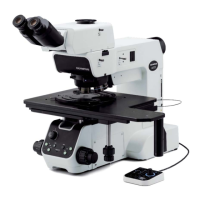5656
5-5 Reflected light IR (infrared) observation procedures
Use the camera which matches the wavelength used with IR.
The infrared light is harmful to your eyes. Be sure to observe the image on the TV monitor.
To improve the IR observation effect, use as many IR-dedicated units as possible (such as the lamp housing, objective,
observation tube, camera adapter, etc.). For IR-dedicated units, contact Olympus.
Notes for using the infrared
· The infrared light generates the significant heat on the sample surface. Pay a careful attention to the sample which is
vulnerable to heat.
· When using the reflected light polarizer, engage the reflected light ND filter (U-25ND6) or the band-pass filter for
reflected light infrared (U-BP1100IR or U-BP1200IR) in the light path on the light source side to prevent the polarizer
from tarnish.
· With the trinocular observation tube (U-TR30IR), the middle position of the 3-level light path selection is used for the
shutter.
Observation
Set the main switch to (ON).
Bring the sample top surface into focus with the visible
wavelength.
Engage the objective with the magnification to be used
in the light path and bring the sample into focus.
Select BF (reflected light brightfield observation).
Insert the band-pass filters
(U-BP1100IR, U-BP1200IR, U-25).
Change to the camera light path.
Main switch P.24
Observation light path selection knob P.25
Light path selection knob P.26
Filter insertion slot P.39
Objective selection button P.28
Coarse focusing knob / Fine focusing
knob
P.29
Objective selection button P.28
Coarse focusing knob / Fine focusing
knob
P.29
Operation part Page

